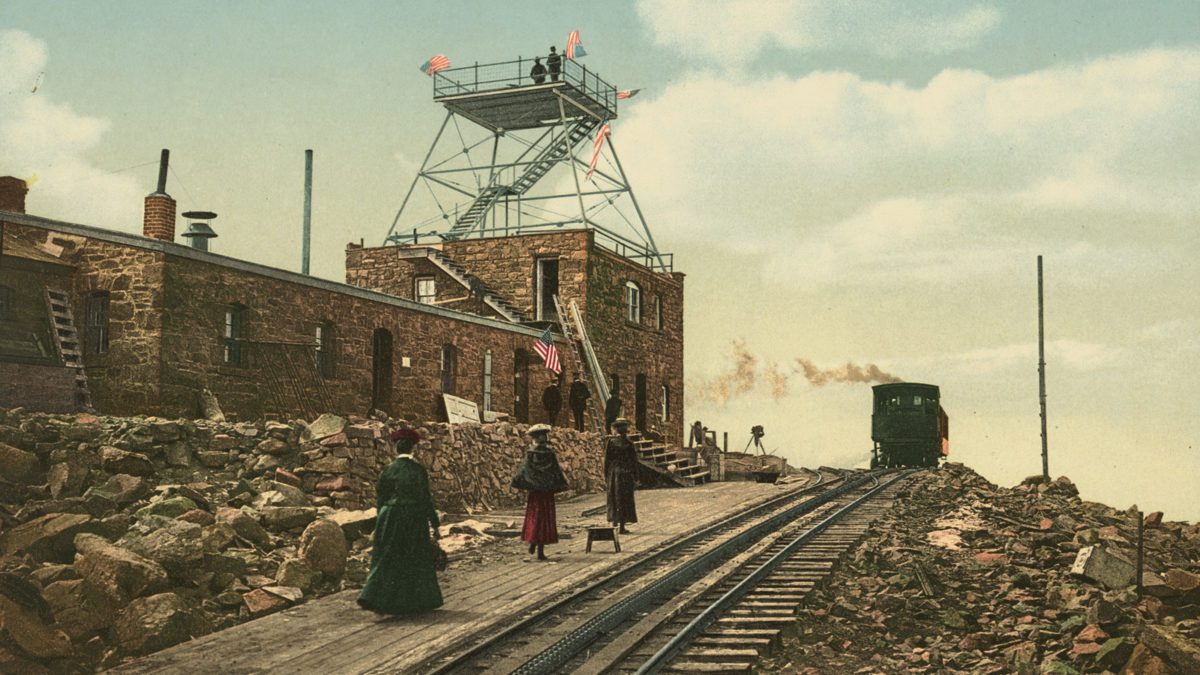
Busted on Pikes Peak
Lawsuits at High Altitude
October 2020

During the Colorado Gold Rush, pioneering treasure-seekers adopted the slogan “Pikes Peak or Bust.” Pikes Peak was not itself particularly rich in gold ore, but it served as a landmark for prospectors who hoped to strike it rich in the Denver area.
Early prospectors who did try to search for gold on the Peak faced a long, arduous trek up the mountain. A good road was not available until the late 1880s. The famous Barr Trail, which allowed travel by burro to the summit, was not finished until 1918.
Meanwhile, in 1891 the Manitou and Pikes Peak Railway Company (MPPRC) began operating a cog railway. Tourists could now travel from Manitou Springs to the top of Pikes Peak in relative comfort.
The MPPRC line ended at a wooden platform. There, passengers could exit the train, climb a wooden staircase, and check in at a hotel known as the Summit House. They could also ascend a tower with a magnificent view of the surrounding countryside or spend their tourist dollars at a nearby curio shop.
The railroad platform was bordered along its length by a stone retaining wall. The wall was constructed to keep loose rocks from falling from the hillside, where the commercial buildings stood, onto the platform and the tracks. The wall, which was several feet high, was not illuminated at night. The accompanying photo shows the layout of the buildings, the retaining wall, and the tracks.
MPPRC owned the summit buildings but leased them to Joseph G. Hiestand. Hiestand operated the Summit House and his curio shop, and paid MPPRC a 25% commission on his gross receipts.1
The Versatile Mr. Hiestand
Hiestand was an interesting character. Known as a photographer, mineralogist, and businessman, he was born in Pennsylvania and later moved to Manitou Springs. There, he owned a hotel and souvenir shop connected with the Ute Iron Spring, famed for its iron-rich mineral water. He was also the official photographer for the MPPRC. His photos of the railroad and surrounding mountain vistas remain striking even today. His curio shops in Manitou Springs and Pikes Peak featured an exotic collection of minerals, souvenirs, stuffed animals, and animal skins.
Hiestand’s mineral collection soon gained international acclaim. Toward the turn of the century he sold part of the collection, including the minerals he had displayed at his shop in Manitou Springs, to a French actress, who proudly displayed them in Paris. Even after that sale, and another to a Pennsylvania dealer, he owned a seemingly inexhaustible collection of rocks and minerals, which he continued selling at his Pikes Peak curio shop. This curio shop was in operation, along with the hotel, when Phillip J. Watson arrived on the evening of July 2, 1902.
Watson Stumbles
Phillip Watson didn’t take the MPPRC train to get to the summit. Instead, he got there the hard way, by walking from Manitou Springs. The 13-mile hike from Manitou Springs to the 14,115-foot summit was a serious undertaking, even for an experienced hiker. Watson did not reach the summit until 10:00 p.m.
Once he arrived, probably quite exhausted, he entered the Summit House and asked for a room. The dismaying reply came back: all the beds were full. But there was another option: an enterprising hotel employee offered Watson his bed for the night for $2.2 Watson accepted, and then retired for the night.
The conditions in the employee’s room, however, proved to be less than ideal. Watson’s mountain climb had left him chilled, and try as he might, he could not get warm in the bed. To make matters worse, “he was annoyed by the presence of two other men who occupied a bed in the same room.”3 After struggling to sleep, Watson got up and wandered into a nearby room, where he found a welcoming fire.
Watson settled in by the fire and sat there for about an hour, until nature called. He asked a Hiestand employee who was working nearby if there was a restroom in the house. The employee told him there was not, and that he would have to go outside.
Watson opened the hotel door and stepped out into the night. The light streaming from the doorway behind him cast a dim glow over the rocky ground. He took a few steps into the lighted pathway, then moved off diagonally into the darkness.
After he had walked about 35 feet into the darkness, Watson stepped off the edge of the retaining wall and fell three or four feet, injuring himself.
The Lawsuit
Watson sued Hiestand and the MPPRC for his injuries on a theory of premises liability. He contended he was MPPRC’s business invitee and MPPRC was liable to him for the unsafe condition on its premises. At the conclusion of the trial he abandoned his claim against Hiestand, conceding that “the accident occurred at a point which Hiestand did not lease from the defendant railway company and over which he had no oversight or control.”4 He sought to blame the railroad for his injuries. But the district court granted a directed verdict (nonsuit) in favor of both defendants, finding that the evidence did not show they were guilty of negligence, and that Watson was guilty of contributory negligence.5
The Appeal
Watson appealed to the Colorado Supreme Court. The Court rejected his claim to be a business invitee of the railroad, stating “[u]nder no possible view of this case can it be said that [Watson] climbed to the top of Pikes Peak upon the invitation of the defendant [railroad] company.”6 Simply put, Watson was not a passenger of the MPPRC, and he visited the summit “for his own pleasure and gratification, and not for the profit or pleasure of the [railroad].”7
Watson made a creative argument: Because MPPRC was entitled to one-fourth of Hiestand’s receipts, and because he had paid $2 for the room, MPPRC had benefited 50¢ from his stay at the hotel. He was therefore a customer/invitee to whom MPPRC owed a duty. But the Court rejected this argument, noting there was “no proof as to whether that $2 was retained by the party who gave up his bed, or whether it went into the hands of the hotel keeper.”8
Reasoning more broadly, the Court noted that MPPRC could not be held liable merely because it was the lessor of the premises; Watson would have to prove negligence, and he had failed to do so. In this regard, the Court found it insufficient to allege that MPPRC “should have placed a railing around the retaining wall, or had permanent lights fixed there so that the wayfarer who sought to wander about on the Peak during the midnight hours might not suffer injury.”9
The Court’s wording seems a bit harsh. Watson was not just wandering around the Peak at midnight; he was looking for a place to use the bathroom. Moreover, it appears he was searching for a place that had been provided specifically by the Summit House for that purpose,10 and that the path to the facilities was not clearly marked or lit.11
The Court also rejected Watson’s claim that the railroad had a duty to warn him about the retaining wall and the dangers of walking on the premises after dark. It reasoned Watson had actual knowledge of the dangers associated with the differing terrain heights on the property, because he must have noticed that feature when he climbed the staircase to reach the hotel. In any event, even if the retaining wall was a “hidden” danger, Watson was only a licensee and MPPRC had no duty to warn him of hidden dangers.12
To add insult to injury, the Court upheld the district court’s finding that Watson had been contributorily negligent. It stated that because Watson knew
that in one direction from the building there was a flight of steps within 16 feet by means of which the retaining wall was ascended, and he knew that he was upon the top of a mountain the sides of which were more or less precipitous, and, not having made any inquiry of parties present concerning the conditions surrounding the building, voluntarily left the portion of the ground which was lighted . . . and walked a distance of some 30 or 35 feet in the dark . . . hastily, it would seem that the thing he might reasonably have expected was to fall over a precipice.13
The Court therefore upheld the directed verdict for the railroad.
Aftermath
In 1971, the Colorado Supreme Court rejected the strict common law distinction between invitees, licensees, and trespassers for premises liability.14 In doing so, it overruled a number of its prior decisions, including Watson.15 The Court’s decision set off a struggle by the Colorado legislature to reinstate the common law rule.16 Colorado’s current premises liability statute does make a distinction between invitees, licensees, and trespassers.17
As for J.G. Hiestand, he came to a strange end. On January 2, 1916, his housekeeper Elsie Ryan found him dead from a gunshot wound in his Manitou Springs home.18 The official story was that he shot himself accidentally while cleaning his guns.19 There have been speculations over the years that he was murdered, but there does not seem to be any solid evidence to support this theory.
The Pikes Peak Cog Railway still exists, but it has been closed for a major overhaul since 2017. It is expected to reopen next spring, much to the delight of Colorado visitors.20 The Summit House, known for its delicious high-altitude doughnuts, is currently undergoing renovations that will result in the construction of a modern 38,000-square-foot facility to be known as the Pikes Peak Summit Complex. Visitors to the Complex presumably will not have to worry about searching a dark mountainside for restroom facilities.
Notes
1. See Watson v. Manitou & Pikes Peak Ry. Co., 92 P. 17, 18 (Colo. 1907).
2. See id.
3. Id.
4. Id.
5. See id.
6. Id.
7. Id.
8. Id.
9. Id.
10. See McFarland, “The Hotel at the Summit of Pikes Peak,” Pikes Peak Courier (Feb. 25, 2020), https://gazette.com/pikespeakcourier/the-hotel-at-the-summit-of-pikes-peak-caboose-cobwebs/article_bd8ba8ca-51ce-11ea-95fe-93e00895cbab.html (stating that circa 1900 at the Summit House, “toilets were still a short walk away, outside.”). (stating that circa 1900 at the Summit House, “toilets were still a short walk away, outside.”).
11. Mountain outhouses were not always conveniently located or identified. To give just two examples known to the author, an outhouse in the ghost town of Nevadaville, above Central City, is perched precariously close to the mountain’s edge. Another outhouse, behind the Thomas House Museum in Central City, appears to have been accessible from the house only by a wooden plank that spanned a large trench.
12. See Watson, 92 P. at 19.
13. Id. at 20.
14. See Mile High Fence Co. v. Radovich, 489 P.2d 308, 314–15 (Colo. 1971).
15. See id. at 311 and n.2.
16. See Pierson v. Black Canyon Aggregates, Inc., 48 P.3d 1215, 1218 (Colo. 2002) (describing the “checkered history” of premises liability in Colorado).
17. See CRS § 13-21-115.
18. See “Shot Kills J.G. Hiestand,” N.Y. Times at p.9, col. 5. (Jan. 3, 1916).
19. Id.
20. Despite construction delays, the Pikes Peak Cog Railway is expected to reopen in May 2021, around the same time as the new Summit House. For updates, see https://www.pikes-peak.com/pikes-peak-cog-railway-closed.
Watson opened the hotel door and stepped out into the night. The light streaming from the doorway behind him cast a dim glow over the rocky ground. He took a few steps into the lighted pathway, then moved off diagonally into the darkness.


